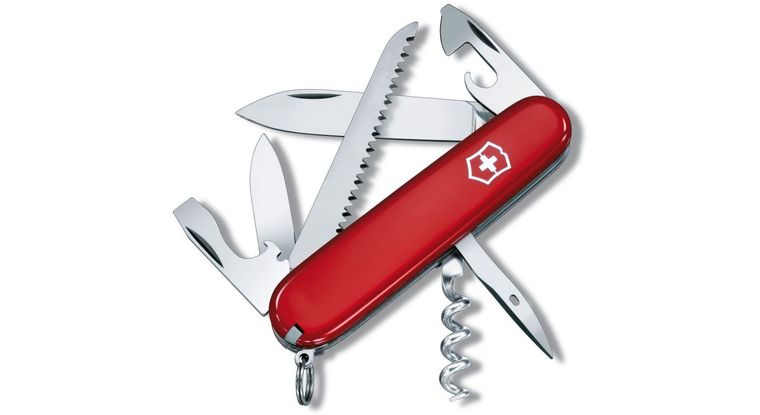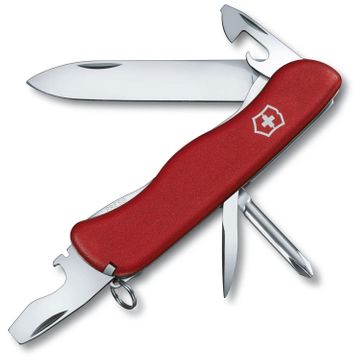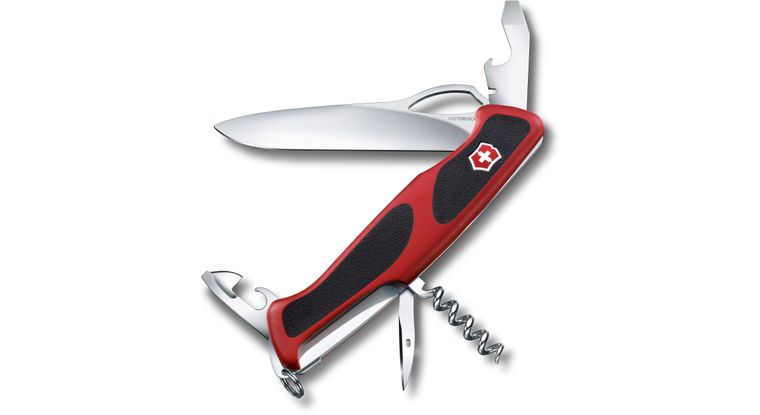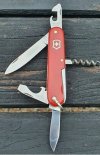-
The BladeForums.com 2024 Traditional Knife is ready to order! See this thread for details: https://www.bladeforums.com/threads/bladeforums-2024-traditional-knife.2003187/
Price is$300$250 ea (shipped within CONUS). If you live outside the US, I will contact you after your order for extra shipping charges.
Order here: https://www.bladeforums.com/help/2024-traditional/ - Order as many as you like, we have plenty.
You are using an out of date browser. It may not display this or other websites correctly.
You should upgrade or use an alternative browser.
You should upgrade or use an alternative browser.
Would you classify a Swiss army as a traditional/classic?
- Thread starter gerberknivesalwaysprevail
- Start date
- Joined
- Oct 5, 2015
- Messages
- 1,892
RangerGrips are my favourite SAKs by far! Is it because I'm a giant and they actually fit my hand nicely? Perhaps...IDK , depends on the model . Some have been around for a very long time , others have been modernized substantially .
Ranger and RangerGrip , for example .
Copied from sakwiki.com :
RangerGrip Models
The RangerGrip series was introduced in the Spring of 2009, after being shown at the SHOT Show a few months earlier.
These models came with a new scale design featuring rubber sections in the handles for better grip.
They were made available for popular models in the 130mm range - these models are indicated with an asterisk (*) in the list above.
The 'Grip' scales also became available for some of the 85mm line.
A few new models were also introduced that were only available with the RangerGrip scales.
- RangerGrip 83
- RangerGrip 86 - East Ranger
- RangerGrip 88 - Rescue
- RangerGrip 90 - Sometimes referred to as the Handyman
- RangerGrip 95 - Rescue
- RangerGrip 179 - Patagonian Expedition – See: Ranger 55
- RangerGrip 181 - See: Alinghi 181/SUI-1
- RangerGrip 182 - Spearfishing
DocJD
Basic Member
- Joined
- Jan 29, 2016
- Messages
- 12,096
That wasn't the question as stated however .Well since the OP has a Tinker Deluxe, we can probably assume thats what he is asking about.....
He's seeking help molding his opinionThat wasn't the question as stated however .
DocJD
Basic Member
- Joined
- Jan 29, 2016
- Messages
- 12,096
Hardly ever see that on this forum !seeking help molding his opinion
DocJD
Basic Member
- Joined
- Jan 29, 2016
- Messages
- 12,096
Same here !RangerGrips are my favourite SAKs by far!
My hands are just medium mens size .
But, I like big knives , the larger tools , locking blade with button release , and a hand filling grip .
The shape ,and rubbery inserts, also help the handle ergonomics , IMO .
Last edited:
- Joined
- Jul 3, 2019
- Messages
- 14,799
I’m sure someone will chime in with a “well actually, Levine says…” but here’s the long and short of it. Besides harking back to the 19th century, take the covers off any SAK and you’ll see the guts of it are exactly like any traditional knife out there. Slip joint spring mechanism and all. My personal feeling is that you can decorate it with bolsters and covers, but that doesn’t change the works.
- Joined
- Jul 30, 2006
- Messages
- 43,837
Would you classify a Swiss army as a traditional/classic?
Would you?
Speaking as one of the moderators of the Traditional Forum: it depends on the model.
>Most SAK's are what we would term a "lobster pattern". That's a legit pattern which has existed for several hundred years.
>Synthetic materials have been used as knife handle materials for over 100 years. Ditto for metal. That makes them a traditional material.
>Stainless steel has been used for knife blades for almost 100 years, so that's traditional also.
>The SAKs with locking blades use a traditional liner locking mechanism, as opposed to a Walker Liner Lock.
So a pattern such as the Tinker is Traditional. So are the Alox patterns such as the Pioneer. And many of the new multi-blade models which have a locking main blade.
But some of the new multi-blade models have a one hand opening main blades. These are not traditional knives.
Traditional



Not traditional

You gotta read his other slipjoint related post...That wasn't the question as stated however .
More like looking for validation.....He's seeking help molding his opinion
calm
Gold Member
- Joined
- Jan 24, 2022
- Messages
- 1,904
Considering that the Buck 110 is considered a traditional, and it is way newer and more tactical than the usual Victorinox knives I often wonder why some still think that Victorinox/Wenger are not really traditional knives.
There is a whole lot of knife culture and models outside of the US and many models that may no be what some US grandpa was carrying 100 years ago. I think some members would consider even friction folders or Laquioles as non traditional, as they do not remember their specific grandpa carrying one.
Even the barlow pattern that is considered a US staple traditional was not invented in the US. Many patterns were originally imported from Sheffield, and got adopted by the US public. Thus most of what is considered as "US traditional" are variations of European patterns.
I seem to recall that the multiblade knives were a US design/trend. Could be wrong.
There is a whole lot of knife culture and models outside of the US and many models that may no be what some US grandpa was carrying 100 years ago. I think some members would consider even friction folders or Laquioles as non traditional, as they do not remember their specific grandpa carrying one.
Even the barlow pattern that is considered a US staple traditional was not invented in the US. Many patterns were originally imported from Sheffield, and got adopted by the US public. Thus most of what is considered as "US traditional" are variations of European patterns.
I seem to recall that the multiblade knives were a US design/trend. Could be wrong.
I think that there are few people in places like Sheffield and Solingen that would disagree....I seem to recall that the multiblade knives were a US design/trend. Could be wrong.
DocJD
Basic Member
- Joined
- Jan 29, 2016
- Messages
- 12,096
I grew up with, and got over them, long ago .slipjoint
IMO only ,lock technology has improved and made them functionally obsolete , for my uses .
calm
Gold Member
- Joined
- Jan 24, 2022
- Messages
- 1,904
feel free to speak on their behalf, giving some examples. I was not absolute in my post.I think that there are few people in places like Sheffield and Solingen that would disagree....
- Joined
- Jul 3, 2019
- Messages
- 14,799
feel free to speak on their behalf, giving some examples. I was not absolute in my post.
I believe the first multi tool “pocket” knife was made by the Romans. It was a friction folder. I can’t find the article at the point, but I recall reading something about it.
I believe credit for the more modern multi tool still goes to Europe. Here’s some evidence:
The Swiss Army Knife was not the first multi-use pocket knife. In 1851, in Moby-Dick(chapter 107), Herman Melville mentions the "Sheffield contrivances, assuming the exterior – though a little swelled – of a common pocket knife; but containing, not only blades of various sizes, but also screw-drivers, cork-screws, tweezers, awls, pens, rulers, nail-filers and countersinkers."
calm
Gold Member
- Joined
- Jan 24, 2022
- Messages
- 1,904
I am not talking about multitools but about multibladed knives. I am aware of the Roman etc knives.
That is why I also mentioned "trend" in my post.
As far as I recall most European or African or Asian, common knives used to be single bladed, with the occasional two bladed pen knife etc.
The trend for popular multiblade knives, like the stockman, appears to be a US started or driven one, as far as I can gather from the various posts I recall in this forum. They may have been made in Europe, but the market/driver was the US thus they are a more recent traditional trend.
They seem to have become popular in the New World. This does not mean that nobody made a multiblade kife before the US was formed. I am talking possibly centuries ago, not 100 years ago.
That is why I also mentioned "trend" in my post.
As far as I recall most European or African or Asian, common knives used to be single bladed, with the occasional two bladed pen knife etc.
The trend for popular multiblade knives, like the stockman, appears to be a US started or driven one, as far as I can gather from the various posts I recall in this forum. They may have been made in Europe, but the market/driver was the US thus they are a more recent traditional trend.
They seem to have become popular in the New World. This does not mean that nobody made a multiblade kife before the US was formed. I am talking possibly centuries ago, not 100 years ago.
calm
Gold Member
- Joined
- Jan 24, 2022
- Messages
- 1,904
here is one of the posts that gives me this impression, referencing Levine's book:
Reading Bernard Levine's book, I remember mentioning multiblade pocketknives in 18th Century France and England (e.g. he quotes the French book "The Art of the Cutler" which provides ample illustrations to that too).
Multiblade pocketknives were and still are high end cutlery, being pricey due to more expensive to make and less demand.
It was in the 19th Century USA (especially the 2nd half of the 1800s) where a mass market developed for multiblade pocketknives. That is why most multiblade patterns ever developed are of American origin.
In 19th and early 20th Century Europe multiblades were purchased mainly by the wealthy and aristocrats, while the commoners and peasants continued to use the single blade jacknives, sheperd knives, navajas etc.
After WWII the SAKs came to dominate the pocketknife market in Europe too, and todays the traditional "poorman" single blade jacknives are mostly expensive cutlery items (Laguioles, navajas, German messers, Italian knives etc.)
eveled
Basic Member
- Joined
- Mar 11, 2016
- Messages
- 8,126
I picked NO
I consider them to be in a class by themselves.
Some define them as a multitool. I do not. Again in a class by themselves.
Even though they have been around forever, they went through a significant change in the 70’s early 80’s. The tooth picks tweezers and snap on handles. They seem cheaper, but it was probably just a manufacturing modernization process.
That was when they became ubiquitous.
Here is one from the 50’s. I consider it traditional
I consider them to be in a class by themselves.
Some define them as a multitool. I do not. Again in a class by themselves.
Even though they have been around forever, they went through a significant change in the 70’s early 80’s. The tooth picks tweezers and snap on handles. They seem cheaper, but it was probably just a manufacturing modernization process.
That was when they became ubiquitous.
Here is one from the 50’s. I consider it traditional

Last edited:
- Joined
- Apr 12, 2006
- Messages
- 3,079
That’s a beautyI picked NO
I consider them to be in a class by themselves.
Some define them as a multitool. I do not. Again in a class by themselves.
Even though they have been around forever, they went through a significant change in the 70’s early 80’s. The tooth picks tweezers and snap on handles. They seem cheaper, but it was probably just a manufacturing modernization process.
That was when they became ubiquitous.
Here is one from the 50’s. I consider it traditional View attachment 2651486
VorpelSword
Gold Member
- Joined
- Dec 27, 2007
- Messages
- 1,641
Would you?
Why YES I would.
The SAK style of knife from either Wenger or Vistronix have been around for most of my life (born 1950) so I would defiantly classify most models as both "Traditional" and "Classic".
I might rule out those models that deploy a computer thimb drive and if they come out with one housing a laser pointer or GPS . .
I packed an SAK in my gear when working in the Middle East backthe early 1980s, but today would bring along a multitool instead.
